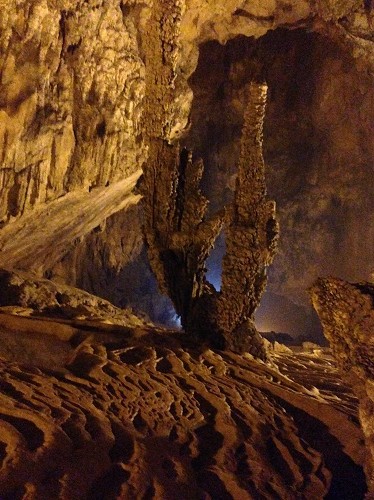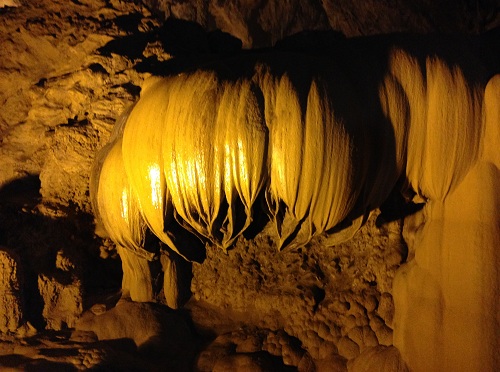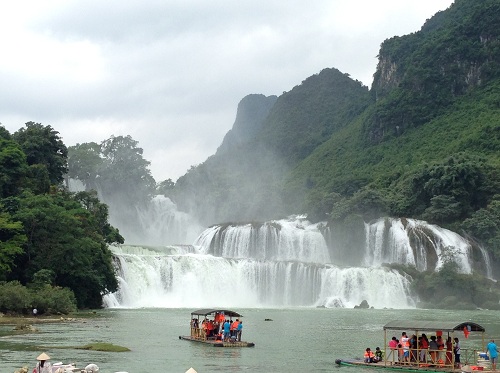.jpg)
Nguom Ngao cave is located in Gun village, Dam Thuy commune, Trung Khanh district, Cao Bang province, in the middle of Gioc Village Waterfall Tourism Area, which has been approved by the Prime Minister as National Tourism Area since 2007. This cave was discovered in 1921 but officially put into tourism in 1996.
According to data from the British Royal Association of Surveyors in 1995, the cave was 2,144m long. There are three main entrances: Nguom Ngao, Ngum Lom (means wind gate with cool air all year round) and Ban Thuon entrance located behind the mountain in Ban Thuon village. Inside, there are many stalactites and stalagmites in various shapes and forms. The temperature ranges from 18 to 25 Celsius degrees, in summer it is cool and in winter it is warm.
According to Tay language, "Nguom" is "cave", "Ngao" is "tiger"; "Nguom Ngao" means tiger cave. Nguom Ngao is divided into three main areas: the four pillars of heaven area with columns against the sky, central area with large spaces and coral reefs rising like giant arms and treasure area with mountain stalactites flashed gold, silver light. All these scenes are created by nature from stalactites and stalagmites, no interference or human placement, creating magnificent scenery, which makes Nguom Ngao distinct with other caves.

Entering the cave, visitors will be overwhelmed in a large space with the magic stalactites shimmering. A variety of colorful stalks rising from the bottom up, from the high domes hanging down with a variety of shapes, reflecting shimmer. The color of stalactites in Nguom Ngao is different from other caves due to the different level of calcium purity in each cave.
The cave is full of senseless stones but they have the ability to broaden the mind and imagination of humans. Visitors can easily see the stones like human figures, forest trees, animals, fairy, giant lotus buds, mother breast and image of President Ho Chi Minh...

One unique feature that makes Nguom Ngao popular is the formation of terraces due to corrosion and weathering in millions of years. Especially, the inverted golden lotus is really a masterpiece of nature. The petals are so flawless just like they were meticulously elaborate.

Another interesting thing about Nguom Ngao is that it has gaps that connect to the sky and at 14:00 pm on April 22nd every year, the sunlight pour through the gaps makes the whole cave shine bright for a few minutes. Perhaps this is an interesting phenomenon that nature gave to Nguom Ngao only.
Nowadays, Nguom Ngao cave is attracting many domestic and foreign tourists to visit and it is considered to be one of the most beautiful caves of Viet Nam. Many visitors say that it would be a big regret if they did not visit Gioc village - visit Nguom Ngao when in Cao Bang.

In addition to Nguom Ngao cave, Gioc village waterfall is also a National Tourism Area (accredited in 1998). There are many other beautiful scenes in Trung Khanh district such as: Ban Viet lake, Ban Da lake, Quay Son river, An Bien, Phuc Lam buddhist temple in Ban Gioc, Thoong Cot, Thoong Ma waterfall (Thong Hue commune), Thoong Loc waterfall (Than Giap commune),... along with Bac Vong river.
In the near future, Trung Khanh district will continue to call for investment and propaganda about the potential of local tourism development to domestic and foreign tourists. Hopefully, Trung Khanh tourism will take a breakthrough development commensurate with its potential.
Fare to visit Nguom Ngao cave: 40,000VND/adult; 20,000VND/child. Fare to visit Gioc village waterfall: 40,000VND/adult; 20,000VND/child. From September to December is the most beautiful time of Nguom Ngao and Gioc village waterfall, due to the dry, cool weather, chestnut and yellow rice season. It is alsso the time that the water in Gioc village waterfall most beautiful. |
Nguyen Manh Hung